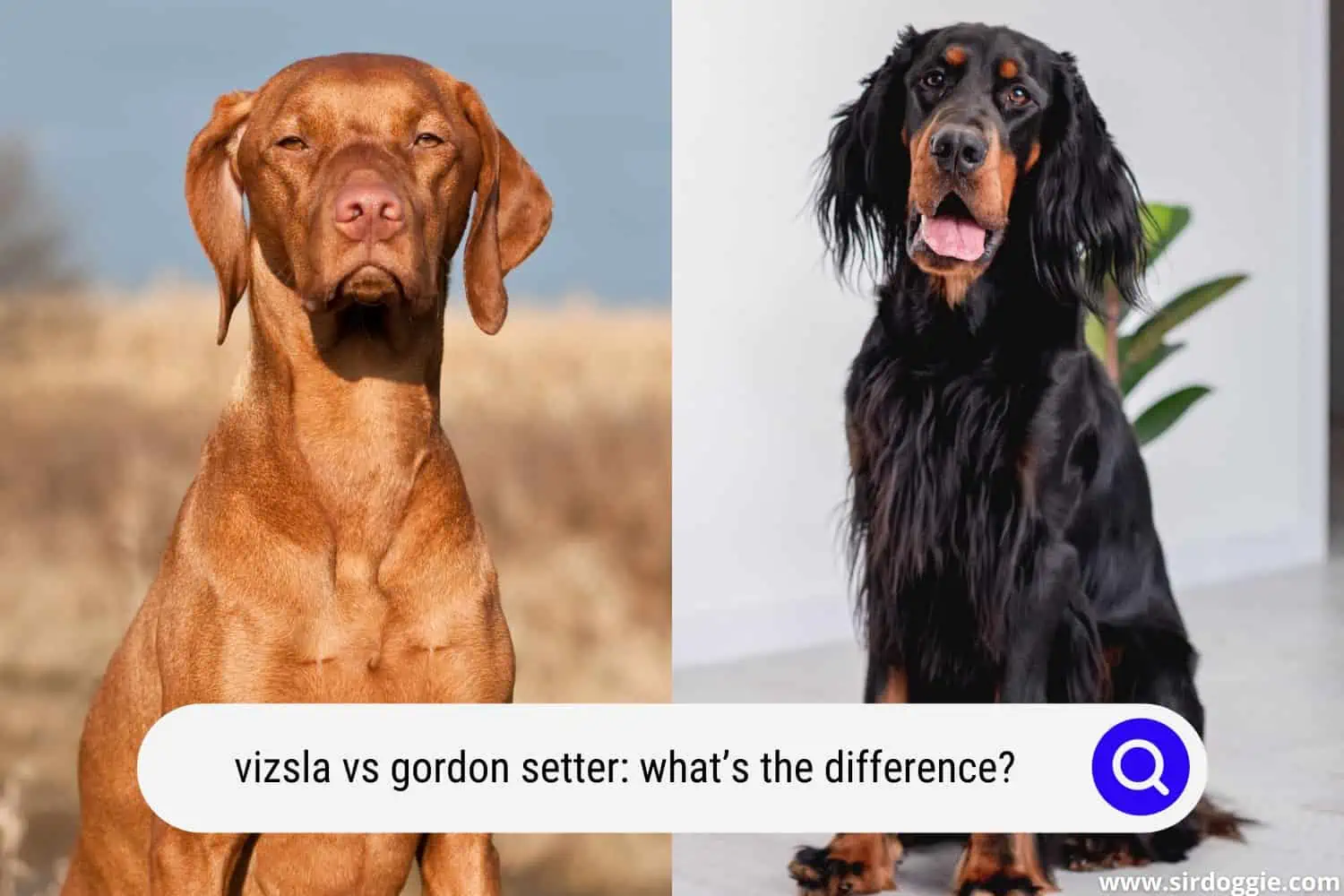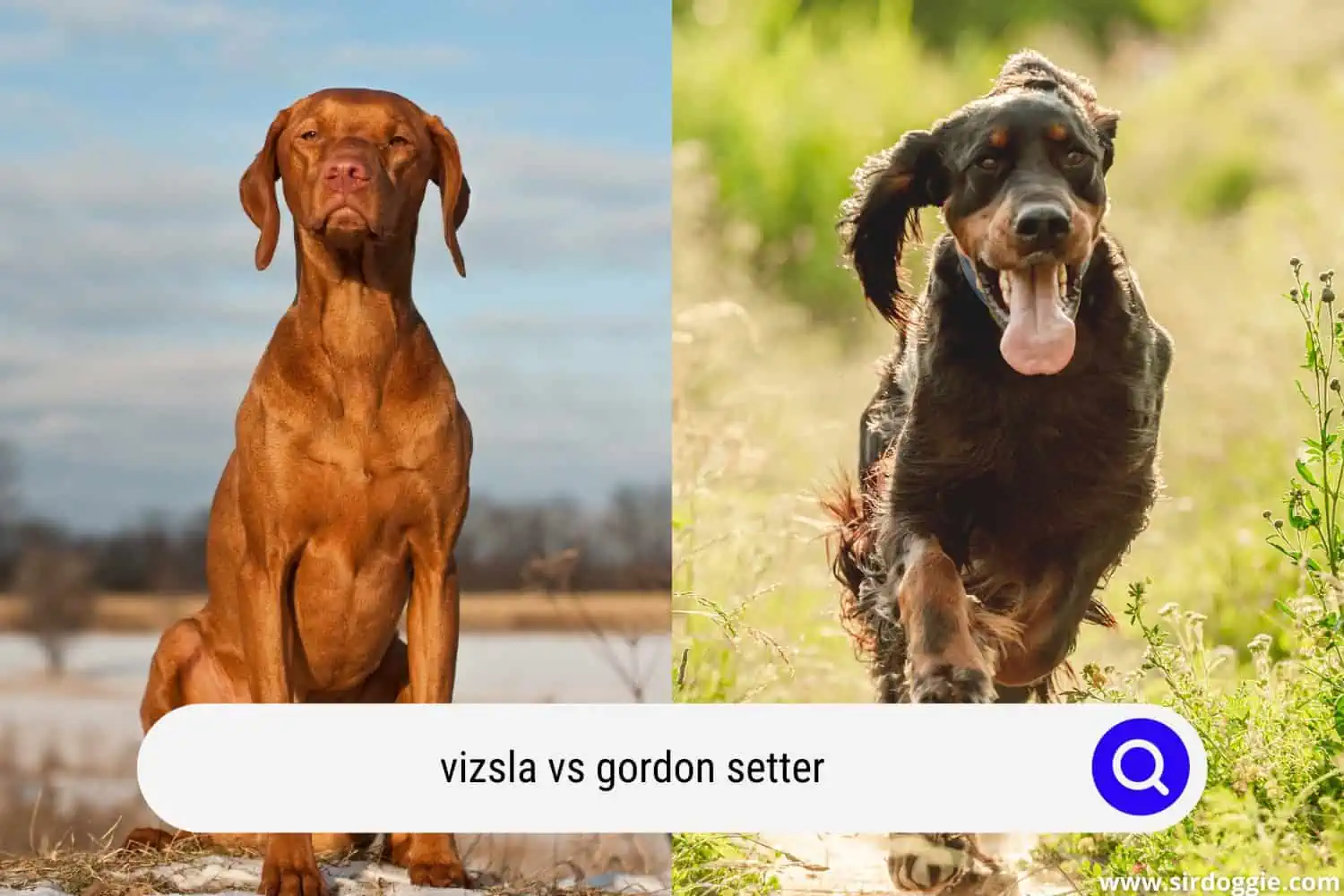Vizsla vs Gordon setter: What’s the Difference?
The Vizsla and the Gordon Setter are two distinct dog breeds from Europe. These medium to large-sized dogs are great working dogs that can be deployed for versatile use.

During the hunt, the Magyar Vizsla are focused and obedient, they are excellent sweat dogs or retrievers as well as good trackers. But apart from work, they are very playful, happy, and lively dogs.
The Gordon Setter is the perfect competitive athlete who can combine high athleticism with astute intelligence and a friendly demeanor. It is active and brave, and as an adult dog, it exudes graceful composure and can be used as a family dog.
In this Vizsla vs Gordon Setter article, we will explain more about the character, characteristics, history, and origin of both breeds. Finally, we’ll compare both breeds in a table chart to help you make a final decision.
Magyar Vizsla
This dog breed of short-haired pointing dog from Hungary is not only very popular in hunting circles but is also often kept as a family dog. Under the right conditions, this is no problem for the brown all-rounder.
Vizsla History and Origins
The four-legged ancestors of today’s Magyar Vizsla or the short-haired Hungarian pointing dog already existed at the time of the migratory Hungarian tribes of the Magyars, who probably originally brought it from Asia to the Carpathian Basin.
Written mentions and descriptions of the breed can be found as early as the 14th century.
When pointers, setters, and other pointing dogs were increasingly bred and used in the 19th century, the Hungarian pointing dog was pushed into the background.
Even today, the Magyar Vizsla is used as a hunting dog and is bred as a versatile dog. It is used to work in the field, in the forest, and in the water. It has a pronounced instinct, firm pointing, excellent retrieval behavior, with great enthusiasm for the water.
Unsteady terrain and bad weather shouldn’t be a problem for it. As an adaptable and friendly companion, keeping it as a family dog is no problem as long as it is used appropriately.
Vizsla’s Essence and character
During the hunt, the Magyar Vizslas are focused and obedient, they make excellent retrievers with a soft catch, as well as good trackers. But apart from work, they are very playful, happy, and lively dogs. Because of their cleverness and excellent maneuverability, they are easy to train, but cannot take a hard hand.
They must not be aggressive, fearful, or shy – sociability and friendly sociability a characteristic of the breed. They seldom leave their caregivers and demand a lot of physical contact.
Because of their high physical performance, it is not easy to exhaust their endless stamina and use them according to their original task. They are therefore only recommended for sporty people or families.
Vizsla Appearance
The Vizsla is a medium-sized, elegant-looking hunting dog with a dry, lean physique that reflects the strength and endurance of the breed. The head is also noble and dry and has a broad muzzle with large nostrils and strong jaws.
The medium-sized, slightly oval eyes are light blue when the puppies are born, but later adapt their color to the coat. But those with the darkest possible eye color are preferred. The large ear flaps are very fine, lie against the cheeks, and end in a slight V-shape at the bottom.
The thin tail is set low and strong at the base but tapers towards the end. In countries without a docking ban, it is generally shortened by a quarter for hunting purposes, otherwise, it extends to the ankle. The dog moves with a lively, expansive, and light-footed trot. There are small webbed feet between the toes to facilitate movement in the water.
The fur dress of the Vizsla is short and dense without an undercoat. On the body, it feels coarse and hard, on the head, it can be a little softer and silky. Its colors include various shades of the characteristic bread roll yellow. Red, brownish, lightened colors or large white markings are undesirable.
However, since this color is tied to a recessive gene, the puppies, especially from crossbreeds, can quickly lose this special color. The lips, eyelids, and nose are similarly bright.
Vizsla Health
The Vizslas are very healthy and physically fit dogs that can easily live to be 12 to 15 years old. The breeding of this breed is subject to strict health guidelines: For example, bitches are only allowed to have a maximum of four litters in their life, and bitches and dogs must have a minimum breeding age of 18 months.
Related Reading: Vizsla vs Papillon: What is the Difference?
The Gordon Setter
With its intelligent look and noble posture, the Gordon Setter looks like the nobleman after whom it was named. However, they are also fun-loving companions on every outdoor adventure!
Gordon Setter’s History and Origins
The Gordon Setter story begins in medieval Scotland, where it was bred and used as a popular hunting dog. They wanted persistent and large working dogs that looked not dissimilar to the spaniel.
Uniform coat colors were not common at that time, so it came in many different colors and shades. These ancestors were simply called “Scottish Setters” and are no longer present in their former form. In the middle of the 19th century,
however, dog breeders tried to develop a stable type based on the Scottish dogs, which was named “Gordon Setter” by the British Kennel Club in 1924 after the noble breeder Alexander Gordon, Duke of Richmond, and Gordon. It had founded the pure breed of this breed at its castle, Gordon Castle, around 1800.
Even today, the Gordon Setter is a popular hunting dog with a high affinity for classic fieldwork. But it is also a great companion and friend for physically active people or families and is not only valued for its many good qualities across the English Channel.
Gordon Setter’s Essence and character
The Gordon Setter is the perfect competitive athlete who combines high athleticism with astute intelligence and a friendly demeanor.
It is active and brave, and as an adult dog, it exudes the graceful composure for which it is known. In its first years of life, the bundle of energy is, unfortunately, a little less balanced and can be downright impetuous, but those who educate with consistency, and patience, will find a docile and willing student in the Gordon Setter.
For these animals with a strong hunting instinct, solid basic commands are particularly important, which must be followed in all situations. Otherwise, you cannot lead them without a leash in the forest or near fields. However, dogs of the breed are open, smart, and socially very compatible.
Gordon Setter Appearance
The Gordon Setter is an elegant, large dog with the harmonious body proportions of a capable hunter. The head is deep rather than broad, the muzzle is large and black. The expressive eyes may only be dark brown, light eye colors or two-tone colors are not the best.
The low-set ears are medium in size and quite thin. The tail is usually straight, but sometimes, it can be curved in the shape of a saber. In both cases, it must not extend in length beyond the hocks.
The fur of the Gordon Setter is moderately long, smooth, and without curls or waves, only on the head, on the front of the legs, and on the tips of the hangings is it short and fine.
The flag of the tail begins near the base of the tail and the belly may have longer fringes up to the chest or neck. The only permissible coat color is deep, shiny coal-black without a rust shimmer with a chestnut red. White markings are not welcome (except for a small patch on the chest).
Gordon Setter Health
As robust hunting dogs, Gordon Setters are usually in good health. You can expect a lifespan of 1 to 14 years. As with many large dog breeds, however, isolated cases of hip dysplasia (HD) can occur; Serious breeders can, however, show in writing that the parents are both HD-free.
Other breed-specific hereditary diseases include occasional eyelid malpositions and possible progressive retinal atrophy (PRA), a retinal death that ultimately leads to blindness.
Here, too, reputable breeding associations ensure that affected animals are prevented from reproducing. Otherwise, Gordon Setters are very healthy dogs that have a great urge to move – however, in dog sports such as agility, care should be taken not to overload the joints.
Vizsla vs Gordon Setter: a side-by-side comparison:
| Vizsla | Gordon Setter | |
| FCI group | Group 7 (pointing dog) | Group 7 (pointing dog) |
| Country of origin | Hungary | Great Britain |
| Height at withers | Males: 58 – 64 cm Bitches: 54 – 60 cm | Males: the average size of 66 cm Bitches: the average size of 62 cm |
| Use | Hunting dogs | pointing dog |
| Life expectancy | 12 to 15 years | 10 to 14 years |
Related Reading: Vizsla vs Braque Francais: What’s the Difference?

Final verdict
Vizslas are capable hunting dogs that can also be used as a family dog. As a talented hunter, the Magyar Vizsla must also be able to keep up with fleeing prey, and over short distances, the dogs can reach top speeds of up to 60 km / h! This makes them one of the fastest dog breeds in the world. Vizslas can stay alive for 12 to 15 years
The Gordon Setter also is an elegant, large dog with the harmonious body proportions of a capable hunter. As robust hunting dogs, Gordon Setters are usually in good health and they can reach up to 14 years of life. The Gordon Setter is prone to hip dysplasia, PRA, and eye malpositions.

Family Dog Expert Author
Hi there! I’m Stuart, a devoted dog lover and family dog expert with over a decade of experience working with our furry companions. My passion for dogs drives me to share my knowledge and expertise, helping families build strong, loving bonds with their four-legged friends. When I’m not writing for SirDoggie, you’ll find me hiking, playing with my beautiful dog, or studying music.